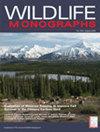冬岭骡鹿对能量发展的行为和人口反应
摘要
人为生境改造是全球生物多样性丧失的主要驱动因素。在北美,过去二十年来,石油和天然气的勘探和生产(碳氢化合物开发)是生境改变的主要来源之一,这导致了许多野生动物物种的人口和行为影响。制定有效的措施来减轻这些影响已经成为野生动物管理者和保护工作者的一项关键任务。然而,这项任务因查明和分离推动人口反应的因素所涉及的困难而受到阻碍。目前关于野生动物对发展的反应的研究主要是量化行为,但并不总是清楚这些反应如何与人口和种群动态相适应。需要同时对行为和人口层面的过程进行评估,以获得制定有效缓解办法所需的机制理解。2008年至2015年,我们同时评估了美国科罗拉多州Piceance盆地冬季地区骡鹿种群对天然气开发的人口统计学和行为反应。值得注意的是,这一时期的开发活动从高水平的活跃钻井下降到只有生产阶段的活动(即没有钻井)。我们将数据收集集中在Piceance盆地内两个相邻的骡鹿冬季范围研究区域,这些区域经历了截然不同的油气开发水平。通过研究近400只成年雌性骡鹿的栖息地选择模式,我们评估了骡鹿对一系列与不同水平的人类活动相关的发育特征的行为反应。同时,我们通过比较两个研究区域的成年雌性和越冬小鹿(6月龄动物)的年存活率、12月小鹿质量、成年雌性冬末和初冬体脂、年龄、妊娠率、胎儿数和12月的泌乳率,评估了天然气开发的人口统计学和生理效应。2个研究区在生境选择上存在明显差异。欠发达地区的鹿在白天和夜间都避免发育,并选择假定用于觅食的栖息地。在高度发达的研究区内,鹿选择的栖息地被认为在更大程度上被用作热覆盖和安全覆盖。面对较高的开发密度,鹿在白天避开有更多井垫的区域,在夜间做出中立反应或选择这些区域。两个研究区域的鹿都显示,正在钻探的井台周围区域的使用大大减少,这是与人类存在、车辆交通、噪音和人造光最多相关的能源开发阶段。尽管栖息地选择模式不同,但我们没有发现发育对个体状况或繁殖的影响,也没有发现在种群水平上测量的任何生理或生命速率参数的差异。而低开发地区的鹿密度和年密度增长率较高。因此,记录的行为改变似乎与在个体水平上测量的人口或生理成本无关,可能是因为种群低于冬季范围的承载能力。这两个地区之间的人口密度差异可能是在我们的研究开始之前(当开发开始时)人口减少的结果,或者是栖息地质量、幼鱼分散、新生儿或幼鱼存活率等地区特有差异的结果;然而,我们缺乏必要的数据来对比这些机制的证据。根据我们的研究结果,鹿似乎可以在生产阶段(景观上人类活动明显减少的时期)适应相对高密度的井台,只要有足够的植被和地形覆盖,种群低于承载能力。在钻井开发阶段对油井的强烈反应表明,减缓工作应侧重于这一活动和开发阶段。该地区的许多井都是由多口井组成的定向钻井,这减少了干扰的足迹,但仍然存在强烈的行为反应。我们的研究结果还表明,专注于减少人类活动(即车辆交通、灯光和噪音)的缓解努力的可能价值。综上所述,这些研究结果表明,应注意最终开发足迹的空间配置,以确保足够的覆盖。在我们的研究系统中,通过景观层面的发展规划来减少道路网络是有价值的(即探索最大道路密度标准)。最后,我们的研究强调了同时评估行为和人口的重要性,以便全面了解野生动物对栖息地改变的反应。 ©2021野生动物协会。Anthropogenic habitat modification is a major driver of global biodiversity loss. In North America, one of the primary sources of habitat modification over the last 2 decades has been exploration for and production of oil and natural gas (hydrocarbon development), which has led to demographic and behavioral impacts to numerous wildlife species. Developing effective measures to mitigate these impacts has become a critical task for wildlife managers and conservation practitioners. However, this task has been hindered by the difficulties involved in identifying and isolating factors driving population responses. Current research on responses of wildlife to development predominantly quantifies behavior, but it is not always clear how these responses scale to demography and population dynamics. Concomitant assessments of behavior and population-level processes are needed to gain the mechanistic understanding required to develop effective mitigation approaches. We simultaneously assessed the demographic and behavioral responses of a mule deer population to natural gas development on winter range in the Piceance Basin of Colorado, USA, from 2008 to 2015. Notably, this was the period when development declined from high levels of active drilling to only production phase activity (i.e., no drilling). We focused our data collection on 2 contiguous mule deer winter range study areas that experienced starkly different levels of hydrocarbon development within the Piceance Basin.
We assessed mule deer behavioral responses to a range of development features with varying levels of associated human activity by examining habitat selection patterns of nearly 400 individual adult female mule deer. Concurrently, we assessed the demographic and physiological effects of natural gas development by comparing annual adult female and overwinter fawn (6-month-old animals) survival, December fawn mass, adult female late and early winter body fat, age, pregnancy rates, fetal counts, and lactation rates in December between the 2 study areas. Strong differences in habitat selection between the 2 study areas were apparent. Deer in the less-developed study area avoided development during the day and night, and selected habitat presumed to be used for foraging. Deer in the heavily developed study area selected habitat presumed to be used for thermal and security cover to a greater degree. Deer faced with higher densities of development avoided areas with more well pads during the day and responded neutrally or selected for these areas at night. Deer in both study areas showed a strong reduction in use of areas around well pads that were being drilled, which is the phase of energy development associated with the greatest amount of human presence, vehicle traffic, noise, and artificial light. Despite divergent habitat selection patterns, we found no effects of development on individual condition or reproduction and found no differences in any of the physiological or vital rate parameters measured at the population level. However, deer density and annual increases in density were higher in the low-development area. Thus, the recorded behavioral alterations did not appear to be associated with demographic or physiological costs measured at the individual level, possibly because populations are below winter range carrying capacity. Differences in population density between the 2 areas may be a result of a population decline prior to our study (when development was initiated) or area-specific differences in habitat quality, juvenile dispersal, or neonatal or juvenile survival; however, we lack the required data to contrast evidence for these mechanisms.
Given our results, it appears that deer can adjust to relatively high densities of well pads in the production phase (the period with markedly lower human activity on the landscape), provided there is sufficient vegetative and topographic cover afforded to them and populations are below carrying capacity. The strong reaction to wells in the drilling phase of development suggests mitigation efforts should focus on this activity and stage of development. Many of the wells in this area were directionally drilled from multiple-well pads, leading to a reduced footprint of disturbance, but were still related to strong behavioral responses. Our results also indicate the likely value of mitigation efforts focusing on reducing human activity (i.e., vehicle traffic, light, and noise). In combination, these findings indicate that attention should be paid to the spatial configuration of the final development footprint to ensure adequate cover. In our study system, minimizing the road network through landscape-level development planning would be valuable (i.e., exploring a maximum road density criteria). Lastly, our study highlights the importance of concomitant assessments of behavior and demography to provide a comprehensive understanding of how wildlife respond to habitat modification. © 2021 The Wildlife Society.

 求助内容:
求助内容: 应助结果提醒方式:
应助结果提醒方式:


